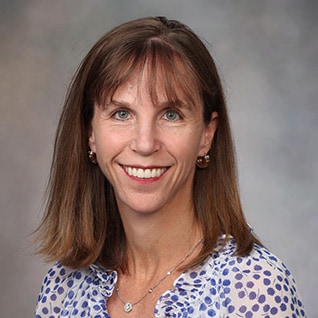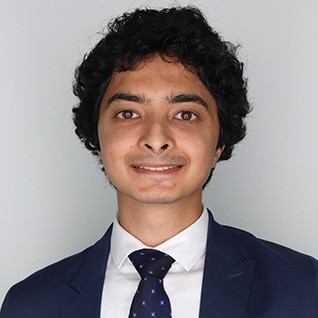Mayo Clinic Graduate School of Medical Education has more than 2,000 residents and fellows enrolled in programs across the country. Of its 300-plus programs, 201 are accredited by the Accreditation Council for Graduate Medical Education, which accredits core specialties and most subspecialties. Ninety-five percent of Mayo's graduate medical education training programs are above the national average in board passage rates.
/prod01/channel_2/media/mccms/content-assets/about/news/aug-oct-2024/1024X512_Internal-Med-AZ-residents-faculty-1593848_3847586_0019.jpg)
September 25, 2024
More than 600 future physicians recently began training at Mayo Clinic School of Graduate Medical Education. Learn about the school and physicians beginning their professional journeys at Mayo. This article is part three of a four-part series welcoming residents across Mayo Clinic.
Sarah Umar, M.D., is among those in Mayo Clinic School of Graduate Medical Education who help learners through this important transition.
 Dr. Umar, program director of the Internal Medicine Residency Program at Mayo Clinic in Arizona, says that although it's not without challenges, educating residents is what "fills up my cup."
Dr. Umar, program director of the Internal Medicine Residency Program at Mayo Clinic in Arizona, says that although it's not without challenges, educating residents is what "fills up my cup."
After completing college, medical school and residency in the Midwest, Dr. Umar came to Arizona for a Gastroenterology Fellowship at Mayo Clinic. She says it has been a privilege to be at Mayo ever since. She leaped at the opportunity to serve as the associate program director for the Gastroenterology Fellowship Program, her first foray into education, before becoming director of the Internal Medicine Residency Program.
"I really found my place educating residents. It's what gets me up in the mornings," says Dr. Umar, who has held her current program director position for over two years.
Dr. Umar understands the importance of helping her learners through the transition of entering residency. Each first-year resident is assigned a faculty coach (separate from their faculty mentor) to help them get through the day-to-day of residency. There is also a buddy program that pairs each new resident with a senior resident they can learn from and ask questions.
Of interest to many trainees, the three-year Internal Medicine Residency Program provides a month of dedicated time for research, service-learning opportunities, and a health equity curriculum.
Combining interest in artificial intelligence with medicine
Samarth Rawal, M.D., a first-year resident in Arizona's Internal Medicine Residency, was drawn to Mayo Clinic because of the high caliber of clinical care and the opportunity to explore innovative and technological healthcare solutions. As a physician, Dr. Rawal hopes to use clinical experience to bring technical innovation and advancements to the bedside.
His interest in combining assisted artificial intelligence with medicine began during his teenage years, when he explored its use to interpret a vast amount of medical data to improve personal interactions.
 The Arizona native was part of the Barrett Premedical Scholars Program while pursuing his degree in computer science from Arizona State University. He says he was inspired by physicians' ability to generate direct, positive care for patients through a combination of developing emotional relationships and harnessing technical knowledge and reasoning.
The Arizona native was part of the Barrett Premedical Scholars Program while pursuing his degree in computer science from Arizona State University. He says he was inspired by physicians' ability to generate direct, positive care for patients through a combination of developing emotional relationships and harnessing technical knowledge and reasoning.
He has a master's degree in computer science, was an artificial intelligence researcher at Mayo Clinic Center for Innovation and attended medical school at an engineering-based program in Illinois. When it came time to decide where to complete his residency, the choice was obvious.
"What attracted me to Mayo Clinic for my residency was the combination of clinical excellence and technological innovation at this institution," Dr. Rawal says. "Through my experiences with Mayo, I have observed a compelling and highly unique degree of organizational belief that AI-driven innovation can have a real impact at the bedside, which manifests as strong institutional support for physicians, encouraging them to explore innovative approaches."
The school's residency curriculum is designed to accommodate and encourage learners to conduct research and innovate while in training. That was important to Dr. Rawal, who plans to pursue a career as a clinician and also be a lifelong researcher, improving healthcare accessibility and efficiency through artificial intelligence.
"I am particularly excited about the opportunity to continue my training at Mayo Clinic because I firmly believe Mayo Clinic in Arizona is poised to become one of the central hubs for clinical AI innovation and implementation worldwide," he says. "My firsthand experiences as an engineer convinced me that Mayo will be an important North Star in guiding clinical-assisted artificial intelligence into the future."
Dr. Umar echoes his statements, emphasizing the important role that graduate medical education plays in developing the future workforce of Mayo Clinic.
"We are training our future colleagues, and it's critical to the mission of Mayo Clinic that we give them the tools they need to keep learning," she says.